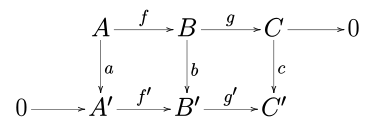Snake lemma
The snake lemma is a tool used in mathematics, particularly homological algebra, to construct long exact sequences. The snake lemma is valid in every abelian category and is a crucial tool in homological algebra and its applications, for instance in algebraic topology. Homomorphisms constructed with its help are generally called connecting homomorphisms.
Statement
In an abelian category (such as the category of abelian groups or the category of vector spaces over a given field), consider a commutative diagram:
where the rows are exact sequences and 0 is the zero object.
Then there is an exact sequence relating the kernels and cokernels of a, b, and c:
where d is a homomorphism, known as the connecting homomorphism.
Furthermore, if the morphism f is a monomorphism, then so is the morphism , and if g' is an epimorphism, then so is .
The cokernels here are:
Explanation of the name
To see where the snake lemma gets its name, expand the diagram above as follows:
and then note that the exact sequence that is the conclusion of the lemma can be drawn on this expanded diagram in the reversed "S" shape of a slithering snake.
Construction of the maps
The maps between the kernels and the maps between the cokernels are induced in a natural manner by the given (horizontal) maps because of the diagram's commutativity. The exactness of the two induced sequences follows in a straightforward way from the exactness of the rows of the original diagram. The important statement of the lemma is that a connecting homomorphism d exists which completes the exact sequence.
In the case of abelian groups or modules over some ring, the map d can be constructed as follows:
Pick an element x in ker c and view it as an element of C; since g is surjective, there exists y in B with g(y) = x. Because of the commutativity of the diagram, we have g'(b(y)) = c(g(y)) = c(x) = 0 (since x is in the kernel of c), and therefore b(y) is in the kernel of g' . Since the bottom row is exact, we find an element z in A' with f '(z) = b(y). z is unique by injectivity of f '. We then define d(x) = z + im(a). Now one has to check that d is well-defined (i.e., d(x) only depends on x and not on the choice of y), that it is a homomorphism, and that the resulting long sequence is indeed exact. One may routinely verify the exactness by diagram chasing (see the proof of Lemma 9.1 in [1]).
Once that is done, the theorem is proven for abelian groups or modules over a ring. For the general case, the argument may be rephrased in terms of properties of arrows and cancellation instead of elements. Alternatively, one may invoke Mitchell's embedding theorem.
Naturality
In the applications, one often needs to show that long exact sequences are "natural" (in the sense of natural transformations). This follows from the naturality of the sequence produced by the snake lemma.
If
is a commutative diagram with exact rows, then the snake lemma can be applied twice, to the "front" and to the "back", yielding two long exact sequences; these are related by a commutative diagram of the form
In popular culture
The proof of the snake lemma is taught by Jill Clayburgh's character at the very beginning of the 1980 film It's My Turn.[2]
See also
References
- Lang, Serge (2005). Algebra (Rev. 3. ed., corr. printing. ed.). New York, NY: Springer. p. 159. ISBN 978-0-387-95385-4.
- Schochet, C. L. (1999). "The Topological Snake Lemma and Corona Algebras" (PDF). New York Journal of Mathematics. 5: 131–137.
- Serge Lang: Algebra. 3rd edition, Springer 2002, ISBN 978-0-387-95385-4, pp. 157–159 (online copy, p. 157, at Google Books)
- M. F. Atiyah; I. G. Macdonald: Introduction to Commutative Algebra. Oxford 1969, Addison–Wesley Publishing Company, Inc. ISBN 0-201-00361-9.
- P. Hilton; U. Stammbach: A course in homological algebra. 2. Auflage, Springer Verlag, Graduate Texts in Mathematics, 1997, ISBN 0-387-94823-6, p. 99 (online copy, p. 99, at Google Books)



